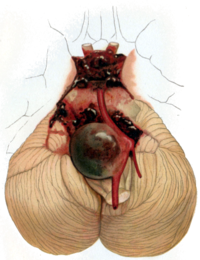
Photo from wikipedia
Dissecting aneurysms of posterior inferior cerebellar artery (PICA) are usually extensions of vertebral artery dissection. Isolated dissecting aneurysms of PICA are extremely rare. A 5-month-old female child presented with history… Click to show full abstract
Dissecting aneurysms of posterior inferior cerebellar artery (PICA) are usually extensions of vertebral artery dissection. Isolated dissecting aneurysms of PICA are extremely rare. A 5-month-old female child presented with history of fall from a height of around 2 ft., followed by incessant crying and multiple episodes of vomiting. The anterior fontanelle was lax. Plain CT scan brain showed IVH in the fourth ventricle with no hydrocephalus. Twenty-four hours after admission, the child had one episode of vomiting and became unresponsive. The child was intubated, and a repeat CT scan brain showed thick acute SDH in the posterior fossa with hydrocephalus. Emergency suboccipital craniectomy and evacuation of thick acute subdural hematoma were done. Organized clot noted in the midline between the tonsils was not removed. Digital subtraction angiography (DSA) done 48 h after surgery showed ruptured dissecting aneurysm of left PICA. Endovascular temporary parent artery occlusion by coil deployment was performed, after which a check angiogram revealed complete exclusion of aneurysm from circulation. Endovascular proximal parent artery occlusion is the preferred treatment modality for dissecting aneurysms of PICA. Selective coil or Onyx embolization of the aneurysm with parent vessel preservation technique is a valid and increasingly used alternative. In this case, a novel technique of endovascular temporary parent artery occlusion by coil deployment was performed successfully. This technique may be recommended in select cases.
Journal Title: Child's Nervous System
Year Published: 2021
Link to full text (if available)
Share on Social Media: Sign Up to like & get
recommendations!